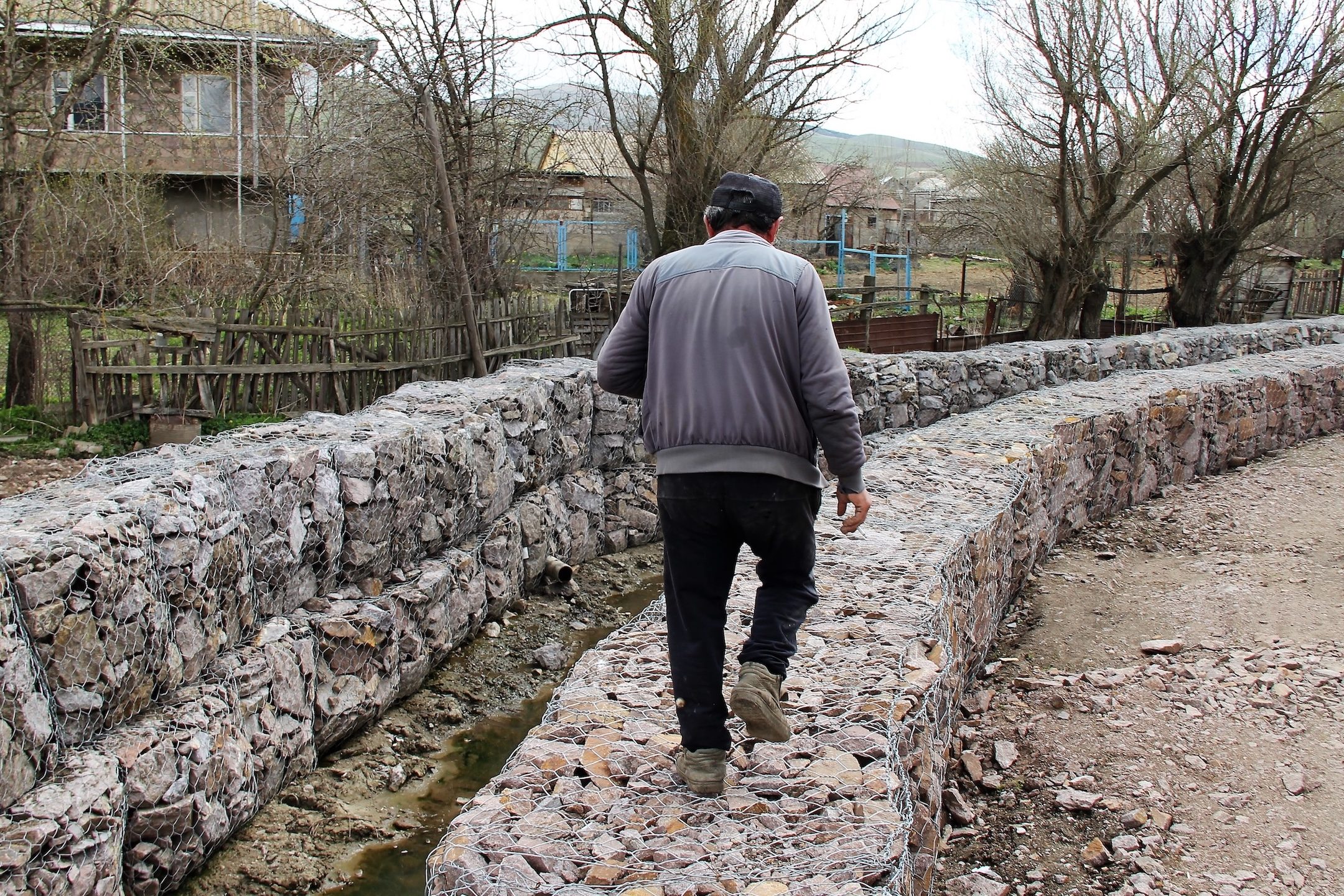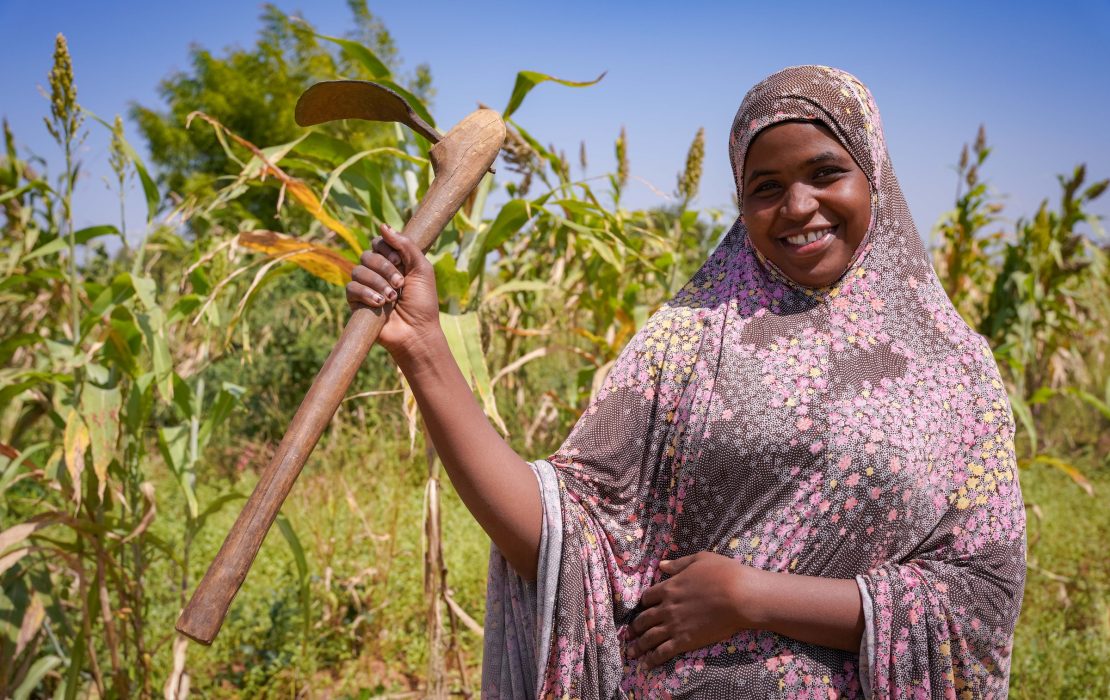
Photo: Arzuman Harutyunyan / UNDP Armenia
Walking through the rugged roads of Chambarak, a village of 6,000 in northeastern Armenia, during springtime, reveals spacious gardens, budding crops, and blooming flowers. It is difficult to imagine that this serene community is vulnerable to devastating mudflows almost every year.
Photo: Arzuman Harutyunyan / UNDP Armenia
And yet Chambarak is located in the Gegharkunik province, one of the regions in Armenia most exposed to climate-induced risks and hazards, including late spring frost, more powerful hailstorms and windstorms, and more severe mudflows.
Photos: Arzuman Harutyunyan / UNDP Armenia
For Susanna Avagyan, a retired teacher who lives by the riverbank, mudflows are nothing short of a nightmare. “It’s very hard for me to talk about the damage the mudflow causes every time it visits us. Once, the river overflowed and washed away everything in its path. Everyone was scared. I barely saved my grandchildren from drowning. It was a nightmare that I never want to relive.”
Photo: Arzuman Harutyunyan / UNDP Armenia
People in Chambarak are primarily engaged in livestock farming and agriculture, and mudflows are a calamity that significantly impacts their livelihoods. Caused by heavy rainfall and snowmelt in the springtime, the mudflows erode the land, destroy crops, and damage infrastructure. In recent years, they have become increasingly intense because of climate change and unpredictable weather patterns.
The women in the community bear the brunt of the disaster. “The men are mostly seasonal workers and are away during the springtime,” explains Susanna. “So, it's up to us, the women, to protect our homes and our families from the mudflows. We’ve learned to cope with the threat of mudflows over the years, but we always suffer losses, always.”
Photos: Arzuman Harutyunyan / UNDP Armenia
When talking about the potential risk and damage caused by the mudflows, Samvel Melkumyan, a retired military serviceman, points to his 2-year-old daughter. “I have young children, elderly parents. Every mudflow is a direct threat to their lives. When they happen, it’s very challenging for me to protect my family and save my property from destruction.”
Samvel’s house is right by the riverbank. Years ago, he built a wall around his property but the protection it offers is minimal.
Photo: Arzuman Harutyunyan / UNDP Armenia
The community does have mudflow channels. Built during Soviet times, the channels worked for a while, but they are now in poor condition due to degradation and pollution. They can no longer prevent the destruction caused by mudflows, especially with climate change causing more intense extreme weather events.
Photos: Arzuman Harutyunyan / UNDP Armenia
But hope is not lost. In the winter of 2022, with funding from Japan, UNDP helped the community in Chambarak build improved defenses. Some residents joined the project team to clean the mudflow channels and build new protective walls. Instead of constructing solid walls made of concrete, these new protections employ a solution inspired from nature, using metal baskets filled with stones from the nearby quarry. They have several advantages, from being able to undergo deformation and release drainage water, to being less carbon-intensive, to costing less and lasting longer.
Photos: Arzuman Harutyunyan / UNDP Armenia
“We used to believe that protective walls were expensive and difficult to build. However, now we see there are other solutions,” says Arsen, one of the residents who took part in the construction works. Arsen and the others have now learned the techniques to maintain the channels and build further reinforcements if needed. Moreover, crucial road renovation and asphalt paving projects that were delayed for years due to possible damage from mudflows, are now able to resume, as the risk of mudslide damage has been reduced to a minimum.
Even though the residents of Chambarak have gained some peace of mind, climate change will continue to have numerous impacts across the country. According to the latest official figures, Armenia has experienced a 1.2° C rise in average temperatures and a 20 percent increase in extreme weather events over the last century. As a landlocked country with mountainous territory and vulnerable agricultural regions, climate change poses a serious threat for current and future generations.
Photo: Arzuman Harutyunyan / UNDP Armenia
Building defenses against extreme weather is just one way in which communities like Chambarak can start adapting to the unavoidable impacts of climate change. Others include diversifying crops and sources of food, improving water management and water storage, taking advantage of specific insurance mechanisms, and improving early warning systems and meteorological forecasting.
Meteorological monitoring and data are essential to adapt and respond to climate-induced risks. Accurate weather forecasting and constant monitoring provide valuable insights into the current and future impacts of climate change on various regions, sectors, and communities.
Photos: Arzuman Harutyunyan / UNDP Armenia
As part of the same initiative funded by Japan, UNDP has helped install 11 modernized automatic meteorological stations in Armenia, including five in the Gegharkunik province.
One of the modernized stations is located very close to Chambarak, on the Lake Sevan peninsula, and currently provides immediate and accurate weather forecasts for the region and beyond.
Shahen Vardanyan has been working at the station for almost 50 years. He has witnessed the evolution of weather forecast technologies and the gradual shifts in climate. “The station was established in 1926, and the technology we relied on for weather forecasts before this upgrade was developed in the 1970s. This new system enables us to receive quick and accurate data by transmitting information every two seconds. By analyzing this data and integrating data from other stations in the region, we can now provide high-quality monitoring and forecasts for our specific area.”
Photos: Arzuman Harutyunyan / UNDP Armenia
Shahen believes the modernization of the station will greatly help mitigate the risks caused by increasingly adverse weather conditions and support the region’s development, particularly in agriculture. “By having access to reliable data and forecasts, farmers can make better decisions regarding crop selection, irrigation schedules, and other crucial aspects of farming, as well as minimize the risks caused by heavy rains, floodings, and mudflows,” he says.
Photo: Arzuman Harutyunyan / UNDP Armenia
While climate change will continue to have unavoidable consequences in Armenia and around the world, adaptation measures like flood protections and improved forecasting services are crucial to minimize risks and increase resilience.
The people in the Gegharkunik province are now better prepared for climate impacts, thanks to these interventions. But as the climate crisis continues to unfold, scaling-up adaptation and resilience measures, alongside mitigation, and ensuring they are available to vulnerable groups around the world, will become ever more crucial.
***
Japan considers that the climate crisis is a threat to all humanity and, in cooperation with UNDP, leads countries to accelerate their climate action.
In 2021, UNDP launched a new phase of Climate Promise – From Pledge to Impact – aimed at translating NDC targets into concrete action. Japan is the largest supporter of this phase and joins longstanding partners such as Germany, Sweden, the European Union, Spain, and Italy and new partners such as the United Kingdom, Belgium, Iceland, and Portugal to accelerate these efforts.

